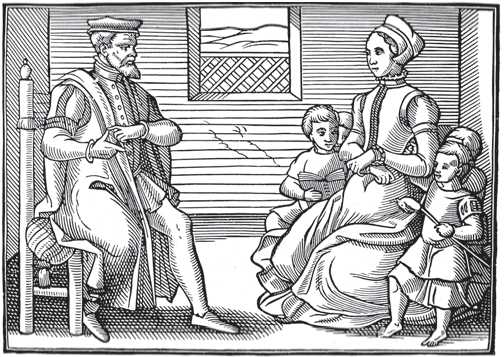English Protestants who believed that the Reeormation had not sufficiently rid the church of Catholic influences were called first by their enemies and later by themselves Puritans.
The Reformation in England began in the reign of Henry VIII (1509-47) and continued in the short reign of his son, Edward VI (1547-53). Mary I (1553-58), a Catholic, attempted to re-establish Catholicism, an effort that led some religious dissenters to flee England for the Continent, where they gained greater knowledge about Reformation ideas from John Calvin, Huldrych Zwingli, and Martin Bucer. After Mary’s death Elizabeth I (1558-1603) promoted Protestantism and aimed to settle religious disputes by establishing a theologically Protestant church that retained some liturgical elements of Catholicism.
From the beginning of the English Reformation, there were those who argued that the English church must be further purified. These Puritans, as they were later called, objected to certain holdovers from Catholic practice such as the use of the sign of the cross in baptism, the wearing of priestly vestments during the liturgy, and the retention of the office of bishops. Further, these religious dissenters disagreed with the open membership policies of the Church oe England. By law, each person born in England was a member of the national church (unless he or she adhered to a non-Christian faith), and every person was thus obligated to support the church through taxation. Dissenters disagreed with this aspect of Anglican theology. Following the logic put forth by St. Augustine, they believed that there were two churches. One church included everyone God had designated for salvation (the “invisible” church); the other included all individuals who adhered to the tenets of Christianity but who might or might not be destined for salvation (the “visible” church). As a result, reformers who objected to certain features of the Anglican church had to decide whether the Church of England, despite its flaws, was a “true” church, or whether its failings obligated believers to leave it and congregate with other true Christians (those destined for salvation). Puritans answered the question both ways: many stayed within the established church, although they might also meet with other like-minded worshipers for private prayer and study. Others, known as Separatists, rejected the Anglican Church and formed their own churches, which were generally small and prone to further division. All Puritans thought of themselves as a holy community of “elect” Christians who sought to live in holy brotherhood. Their theology was noteworthy for its commitment to the doctrine of predestination, the idea that God had, from the beginning of time, chosen some human beings to be saved and others to be damned.
Elizabeth I, hoping to end religious contention during her reign, persecuted both Catholics and Puritans to ensure the survival of her religious settlement. Archbishop John Whitgift, with Elizabeth’s support, required ministers to swear to their support of the Anglican Church, including the monarch’s status as “Supreme Governor” of the church and the use of the Book of Common Prayer. Many Puritans objected to the Book of Common Prayer, and their refusal to subscribe to this text led to the suspension of hundreds of Protestant ministers.
At the end of the 16th century, dissenters continued to find defects in the Church of England and its clergy. In 1600 the Puritan theologian Francis Johnson enumerated 91 erroneous elements of Anglican practice. Among the dissenters’ objections was the fact that many individuals who became priests lacked the necessary training for their posts. Some who held office were, according to Puritan protests, “Dumme Doggs, Unskilful sacrificing priestes, Destroyeing Drones, or rather Caterpillars of the Word”—features that

A Puritan Family: woodcut, 1563, from The Whole Psalms in Four Parts (The Granger Collection)
Would not have been surprising among a people whom one Puritan writer identified as being artisans (such as tailors and shoemakers) or uneducated workers before receiving their appointments. In one of their characteristically caustic volumes, a Puritan writer catalogued the sins committed by clerics in one county in 1586. One was “a notorious swearer, a dicer, a carder, a hawker and hunter, a verie careless person” who had had “a childe by a maid since he was instituted and inducted,” while another “kept a whore long time in his house” and was “unable to preach,” while yet another was “thrice presented for a drunkard.” “With such men for ministers,” the historian Edmund Morgan concluded, “the Puritans foresaw that the membership of the Church of England could never be anything but ignorant, degraded, and corrupt.”
Puritans made repeated protests about the systemic flaws in the Church of England. They argued that local churches needed the authority to punish an individual who had committed a sin, but that power lay vested in the higher officials of the clerical establishment. Unable to purge themselves of individuals whose presence in church would have been, they argued, an insult to God, the dissenters claimed that the Church of England could never be improved, let alone purified. Such beliefs led Puritans to embrace the concept of congregationalism, in which each church would choose its own officers and keep its members in line. Such an organization would also allow the Puritans to do what they wanted most of all: to exclude individuals they deemed unworthy.
Given their criticism against clerical authorities in England, the Puritans often found themselves persecuted. In response, some chose to leave England for the Continent, where they settled among like-minded Protestants. Others chose to stay in England, where they often suffered for their views until after the English civil war of the 1640s. Yet others, arguably the most famous, decided to take their chances in the new English colonies on the eastern shores of North America. Puritans thus came to dominate the so-called Great Migration to New England, which began with the founding of Plymouth in 1620 and extended to 1642. It was thus in New England that Puritans had the opportunity to create churches along the lines they had envisioned, to fulfill their spiritual goals. Over time they would discover how difficult it could be to gather the members of the invisible church together and to maintain godly communities.
Further reading: Patrick Collinson, “Puritans,” in The Oxford Encyclopedia of the Reformation, vol. 3, ed. Hans J. Hillerbrand (New York: Oxford University Press, 1996), 364-370; A. G. Dickens, “The Early Expansion of Protestantism in England, 1520-1558” in The Impact of the English Reformation, 1500-1640, ed. Peter Marshall (London: Arnold, 1997), 85-116; Christopher Durston and Jacqueline Eales, eds., The Culture of English Puritanism, 1560-1700 (New York: St. Martin’s Press, 1996); Edmund S. Morgan, Visible Saints: The History of a Puritan Idea (Ithaca, N. Y.: Cornell University Press, 1965).
—Martha K. Robinson




 World History
World History









